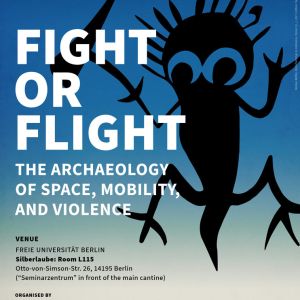"Fight or Flight" – an Exciting Conference in Berlin
Julia Längauer
From April 24th to 25th, the internationally attended conference "Fight or Flight: The Archaeology of Space, Mobility and Violence" took place in Berlin, financed by the Berliner Antike-Kolleg.
The core theme of the conference focused on exploring ways to avoid conflicts and how we, as researchers, can conceptualize and interpret these strategies in an archaeological context. The discussions spanned from the Early Neolithic period through the Late Bronze Age and Iron Age to more recent events in Lampedusa and Tel Aviv.
Franz Pieler and Julia Längauer delivered presentations at the conference, each exploring potential conflict avoidance strategies in the Linearbandkeramik settlement of Asparn/Schletz. Despite the ultimate failure of these strategies, which we resulted as we think in the settlement falling victim to a massacre, the significance of the at least 300 years during which the settlement successfully developed into one of the central locations in the northern Weinviertel should not be overlooked.
Over these at least 300 years, the inhabitants of Asparn/Schletz developed various strategies to either prevent or defend against conflicts. Using strontium isotope analysis and, more recently, aDNA analysis, researchers have been able to determine mobility and kinship among individuals associated with the Linearbandkeramik culture. That daughters of ruling families played an important role in peacekeeping and conflict avoidance as part of marriage politics, not only since the Habsburgs, is not a new insight. These studies show that women were probably more mobile than men in many cases, which is referred to as female exogamy in contrast to patrilocality. This mobility of women was a way to secure trade relations over long distances, maintain peace, and ensure a general exchange – it is reasonable to assume that similar strategies were also used in Asparn/Schletz
Simultaneously, recent investigations indicate that the ditches surrounding the settlement of Asparn/Schletz were repeatedly modified, as they show signs of redeployment, temporary use, and decay. It appears that these ditches were repeatedly dug as needed to protect the settlement and its inhabitants from attackers. A specialized article on this topic will soon be published , so not too much shall be revealed here.
During the conference, Julia Längauer was interviewed by our Berlin "blog colleague" Viktoria Heinemann, who blogs for the Berlin Ancient Studies Network. Once the article is online, we will provide the link. In the meantime, you might already find some interesting posts here: https://bab.hypotheses.org/
Together, both presentations covered a significant portion of our project "United by Crisis?" Did specific relationships, perhaps also forged through clever marriage politics, no longer suffice to protect the settlement? Did recurring conflicts arise with other groups? These exciting questions were discussed by us during the conference and will continue to accompany us in the project.






